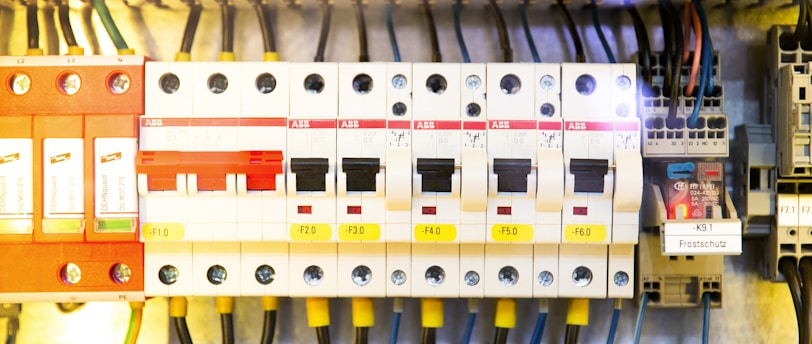Circuit Safeguard : Understanding the Role of Fuse, MCB, MCCB, RCCB, and ELCB
Exploring Fuse, MCB, MCCB, RCCB, and ELCB in Electrical Safety
PARTS
11/7/20233 min read


What is Fuse, MCB, MCCB, RCCB, ELCB ?:-
Electrical protection devices, such as fuses, MCBs (Miniature Circuit Breakers), MCCBs (Molded Case Circuit Breakers), RCCBs (Residual Current Circuit Breakers), and ELCBs (Earth Leakage Circuit Breakers), are essential components in electrical systems to safeguard against overcurrent, short circuits, ground faults, and electrical hazards. In this comprehensive explanation, we'll discuss each of these devices individually, their types, and their uses in electrical systems, providing a thorough understanding of their functions and applications.
Fuses:-
1. Definition:- A fuse is a safety device designed to protect electrical circuits from overcurrent or short-circuit conditions by breaking the circuit when these conditions occur. The working principal of a fuse is based on heating effect of current.
2. Types:- Fuses come in various types, including cartridge fuses, HRC fuse, blade type fuse, smd fuse, axial fuse, plug fuses, resettable fuse, and semiconductor fuses. They can be fast-blow or slow-blow, depending on their response time to overcurrent.
3. Use:- Fuses are commonly used in residential and industrial electrical systems to protect appliances, wiring, and equipment from overcurrent events. They are inexpensive and effective in preventing electrical fires and damage.
How to choose correct size of fuse :- Generally size and type of fuse depends on different factor, but the basic formula for fuse rating is.
Fuse rating = ( Power / Voltage ) × 1.25
In this formula fuse rating is in amp.,
Power of load connected in watts,
Voltage in volts.
MCBs (Miniature Circuit Breakers):-
1. Definition:- MCBs are automatic electrical switches designed to protect electrical circuits by quickly disconnecting the circuit when excessive current or short circuits are detected.
2. Types:- MCBs are categorized based on their tripping characteristics: Type B (standard), Type C (moderate), and Type D (highly sensitive). They are available in single-pole, double-pole, and multi-pole configurations.
3. Use:- MCBs are commonly used in residential, commercial, and industrial electrical panels. They offer rapid protection against overcurrent and can be reset after tripping.
MCCBs (Molded Case Circuit Breakers):-
1. Definition:- MCCBs are robust and higher-rated circuit breakers designed for protecting larger electrical circuits and equipment. They provide adjustable overcurrent protection.
2. Types:- MCCBs can be thermal-magnetic or electronic. They come in various sizes and are often available in fixed or adjustable trip settings.
3. Use:- MCCBs are used in industrial and commercial applications where higher current ratings and adjustable settings are required. They protect large electrical systems and equipment from overcurrent events.
RCCBs (Residual Current Circuit Breakers):-
1. Definition:- RCCBs are devices designed to detect and interrupt electrical circuits when an imbalance in current (e.g., due to ground faults or leakage) is detected.
2. Types:- There are two main types of RCCBs: Type AC (for general use) and Type A (for circuits with electronics and variable speed drives). RCCBs can be single- or double-pole.
3. Use:- RCCBs are vital for protecting against electric shock caused by ground faults or current leakage. They are commonly used in residential, commercial, and industrial applications, especially where water and human contact are prevalent.
ELCBs (Earth Leakage Circuit Breakers):-
1. Definition:- ELCBs are older-generation devices designed to detect current leakage to earth (ground) and disconnect the circuit to prevent electric shock.
2. Types:- ELCBs are typically classified as voltage-operated (VOELCB) or current-operated (COELCB). They can be single-pole or double-pole.
3. Use:- While less common today due to advancements in RCCB technology, ELCBs are used to provide protection against electric shock in older electrical installations.
Key Functions and Uses of These Devices:-
Overcurrent Protection:- Fuses, MCBs, and MCCBs safeguard electrical circuits from excessive current that can cause overheating and damage.
Short Circuit Protection:- These devices respond quickly to short-circuit conditions, preventing damage to wiring and equipment.
Ground Fault Protection:- RCCBs and ELCBs protect against ground faults or leakage currents that can pose a risk of electric shock.
Adjustability:- Some devices like MCBs and MCCBs offer adjustable trip settings to match specific protection requirements.
Resettable:- MCBs and MCCBs can be reset after tripping, making them convenient for temporary issues.
Safety:- All these devices enhance safety in electrical systems, protecting against fires, electrical hazards, and damage to equipment.
Application Specific:- Each device is suited for particular applications based on current ratings, sensitivity, and circuit type.
In summary, electrical protection devices such as fuses, MCBs, MCCBs, RCCBs, and ELCBs play a critical role in maintaining the safety and functionality of electrical systems. Understanding their types and uses is essential for ensuring the proper selection and installation of these devices in elevator & escalator controller.

